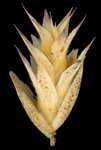
T. chichesterensis spikelet.
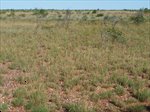
T. chichesterensis habitat.
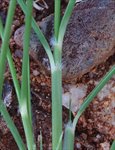
T. chichesterensis orifice.
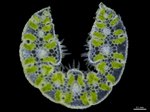
T. chichesterensis leaf section.

T. chichesterensis inflorescence.
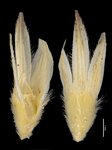
T. chichesterensis lemmas.

T. chichesterensis paleas.

T. chichesterensis map.
Name
Triodia chichesterensis B.M.Anderson, ined.Citation
Austral. Syst. Bot., in press, (2017)
Derivation
chichesterensis — refersto the Chichester region of the Pilbara where this species is found, and the Latin suffix –ensis, from.Common name
Quartzite Spinifex
Synonyms
None
Diagnostic features
Foliage non-resinous; leaf sheath surfaces glabrous; orifice hairs woolly; leaf blades amphistomatous (hard-type), 3–11 cm long; inflorescences with 4–11 spikelets total and 0–3 branches bearing more than 1 spikelet; lower glume elliptic, 6.5–10 mm long, 9–14-nerved; lemmas lobed for at least half their length, bitextured; lemma midlobe hairy; habit on rocky or gravelly substrates, usually with quartzite strew (although these often scarcely outcropping or flat); distribution in the central Chichester sub-region in the north Pilbara.
Habitat
Occurs on sand or loam over rocky or gravelly substrates, often with pieces of quartzite evident at the surface. Although the rocky substrates are often scarcely above the level of a surrounding plain with deeper soils, the difference in substrate is usually sufficient to result in environmental sorting between T. chichesterensis and T. lanigera, since the two species often grow abutting but not intermixed (although in the southern extent of their overlapping distribution both may grow on rocky substrates).
Distribution and frequency
Endemic to the north Pilbara, where it is restricted to the central Chichester sub-region.
Similar species
Triodia chichesterensis belongs to the Basedowii group, sharing the group features of non-resinous foliage, amphistomatous (hard-type) leaf blades and many-nerved (≥6) glumes.
Triodia chichesterensis is distinguished from most species of the Basedowii group (except T. scintillans and T. vanleeuwenii) by having short leaves up to 11 cm long, lemmas lobed for about half their length, and longest basal pedicels more than 3 mm long.
Triodia scintillans and T. vanleeuwenii can be most easily distinguished from T. chichesterensis by the presence of minute sparkling droplets (absent in T. chichesterensis), and having glabrous and generally shorter lemma midlobes 2.2–5.2 mm long (hairy and 4.2–8 mm long in T. chichesterensis); the distributions of the three species do not overlap.
The distribution of T. chichesterensis in the central Chichester sub-region overlaps only with T. lanigera, with which it co-occurs and occasionally hybridizes. Triodia lanigera can be distinguished by having woolly leaf sheaths, longer leaf blades with longest leaves usually >12 cm long and larger inflorescences having 5–38 spikelets and (0)2–9 branches bearing more than one spikelet (T. chichesterensis has glabrous leaf sheaths, leaf blades 3–11 cm long, and inflorescences with 4–11 total spikelets and 0–3 branches bearing more than 1 spikelet). Morphological distinctions between T. chichesterensis and T. lanigera break down in a few hybrid populations.
Conservation status
Priority Three recommended.
Identification without florets
The combination of amphistomatous (hard-type) leaf blades, (≥6) glumes, and distribution in the central Chichester region distinguishes T. chichesterensis from all species except T. lanigera. Triodia lanigera can be distinguished by the characters noted above.
Variation
Occasional hybrids between T. chichesterensis and T. lanigera exist and span the range of intermediate morphology between the two species.
Notes
Triodia chichesterensis was considered under a broad concept of T. lanigera by Lazarides (1997), Lazarides et al. (2005) and Ausgrass (Sharp & Simon, 2002; Simon & Alonso, 2014). A full description of T. chichesterensis can be found in Anderson et al. (2017a).